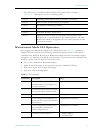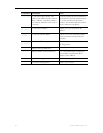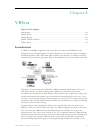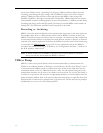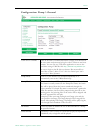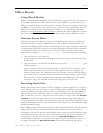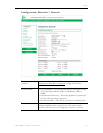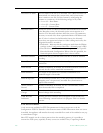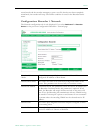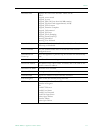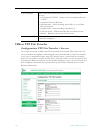
VBStar
VBrick MPEG-2 Appliance Admin Guide 105
VBStar Record
Using Mixed Models
MPEG-2 encoders behave differently when mixed models are present in the same enclosure.
For example when there is a WM encoder in Slot1 and an MPEG-2 encoder in Slot2, the
MPEG-2 recorder becomes an archiver and not a recorder. This section explains in detail how
the MPEG-2 encoder works when functioning as a recorder. For an explanation of how the
MPEG-2 encoder works when functioning as an archiver, see "Configuration: Encoder >
Archiver" in the WM Appliance Admin Guide
. In mixed models with an MPEG-2 encoder in
Slot1 and an MPEG-4 encoder in Slot2, you can only record from the MPEG-2 encoder.
Filename Syntax Rules
Hard drive features are designed to support a root directory and one level of subdirectory
when the hard drive is used for VBStar functions, such as Record, Pump, Playback, and
Automatic and Manual FTP. Filenames for Recording are set on the Configuration: Recorder
> General page in IWS. The syntax for a file name, including the directory name, is limited to
56 characters, consisting of a combination of the directory name, the file name and the
backslash. For example:
d:\directoryname\filename.ext. The following syntax rules apply.
• One sub-directory level is allowed.
• 56 total characters are allowed, including up to 25 in the directory name and up to 25 in
the file name.
• Only 25 characters are allowed in the directory name. Note: \ " : * ? > < ¦ [ ] are
invalid characters.
• Only 25 characters are allowed in the file name (of which 23 can be entered by a user).
The last two characters are reserved for an index number from 1-99 to support the
option of batch mode. The restriction on the root filename exists even if batch mode is
not enabled to allow a switch to batch mode without requiring a change to the filename.
• The extension (.ext) has a maximum three characters, only alphanumeric. The default
extension is .mpg. The allowable extensions are .mpg, .m2g, .m2t and .m2v.
Recording Batch Files
Batch mode records video in pieces. It allows a VBrick to transfer segments of a conference,
event, training session, or any video, to a remote VBrick, while continuing to record. Batch
processing minimizes the delay inherent with store-and-forward video, providing MPEG-2
video in near-real time. Batch files names are created in the Recorder: General section of
IWS. A batch file is one of a group of files that are handled as a single entity. The
Recorder
File Name
is the base file name of the batch, for instance filename.mpg. Three digits are
reserved at the end of the base file name to signify the index number of the batch file. Index
numbers are assigned to the base file name from 1–999 as files are recorded (filename1.mpg
through filenamexxx.mpg).
When VBStar creates a file for batch record, two files are created; the first is the file currently
being recorded, and the second is the next index file, readied to receive data. Video is
recorded into a batch file until the batch duration time is reached, or 4 GB, whichever comes
first. When the first file is full, the new file becomes the target of the record operation. In
batch mode, if the batch base file name is used as the
Recorder File Name, the first file
recorded will be numbered one greater than the most recent file recorded. For instance, if
test.mpg is selected as the Recorder File Name, the batch file numbering will start at



